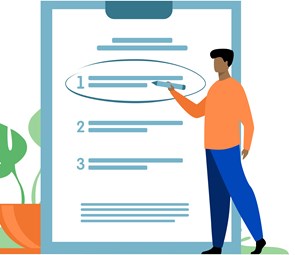Managing anxiety part 2: Polyvagal breathing techniques
Gemma Scotcher, our Director of Communications and Public Affairs, spends a lot of time visiting schools and colleges, talking about the effects of stress and anxiety on our bodies and brains. She also has ADHD and Cyclothymia.
Find out what she’s learnt about Polyvagal breathing and how it has helped her manage her own anxiety.
Articles / 3 mins read

I talked in my first blog about regularly visiting schools and colleges to talk about mental health and wellbeing. In fact, I’m writing this blog on the train to a Union meeting in the South East to do just that!
People are often surprised when I tell them how anxious I get before speaking engagements. Despite coming across as a confident person, my body’s stress response just goes into overdrive before I speak publicly.
What really helps me is Polyvagal breathing techniques. Before you’re totally put off by the jargon, let me give a bit of context.
Polyvagal Theory was developed by American psychologist and neuroscientist, Stephen Porges. It’s a theory that centres on the human nervous system and the role it plays in our ‘fight or flight’ responses.
If you’ve been to a yoga class you may well have been left scratching your head – like me – when the instructor talks about activating the parasympathetic nervous system. That’s straight out of Polyvagal theory.
Central to Polyvagal theory are the following ideas:
- The human nervous system is responsible for our ‘fight or flight’ response.
- Through an unconscious process called ‘neuroception’ we scan the environment and assess whether threats are present.
- If a threat is perceived and ‘fight or flight’ is activated, this is the activation of our sympathetic nervous (SNS).
- If we’re only picking up on positive and safe messages through neuroception, then our parasympathetic nervous system (PSNS) is activated. This is what your yoga teacher might have called ‘rest and digest’ mode.
- The vagus nerve – a big nerve that runs from your brain to the large intestine – is responsible for ‘rest and digest mode’ and we can return to this state of wellbeing by activating the vagus nerve.
Proponents of Polyvagal Theory would advise that if you are stressed, stuck in ‘fight or flight’, to feel better you simply need to move into ‘rest and digest’ by activating your vagus nerve. Once your vagus nerve is activated you’ll move into your ‘window of tolerance’ (i.e. a physical state that you are able to literally tolerate without becoming stressed – everyone’s window is different) and the ‘rest and digest’ mode of the PSNS will kick in. This will make you feel calmer, lower your blood pressure and slow your heart rate, which is all good for tackling the long term impact of chronic stress.
Sounds brilliantly simple, doesn’t it? It took me a lot of practice. It can be hard to remember to have rational thought when you’re in the middle of a panic attack or stress response, but with practice I did find that I was able to think ‘remember the vagus nerve!’
What can activate the vagus nerve?
- Breathing exercises
- Singing
- Humming
- Chanting
- Gargling
- Cold water immersion
- Meditation with a focus on deep breathing
- Massage
- Music
Some of these activities are readily accessible, whereas some require a bit more time investment. The one I’ve managed to successfully incorporate into my day – especially as I prepare for those anxiety inducing speaking engagements – is breathing.
Proponents of Polyvagal Theory say that breathing exercises that involve a longer exhalation than inhalation activate the vagus nerve. Maybe that’s true? Maybe I’m just releasing some of the DOSE ‘feel good’ hormones I talked about in part one of this blog? I’m not sure, and maybe it doesn’t matter, but I do know it works for me.
The following breathing exercise is my fail safe for mentally preparing – or recovering from – anxiety inducing moments at work.
- Set a timer on your phone – I do about 10 minutes but you could start with three or five
- Close your eyes and get comfortable
- Tune into your regular breathing
- Inhale to a count of 1-2-3-4
- Hold your breath for 1-2-3-4
- Exhale for 1-2-3-4-5-6
- Hold your breath for 1-2-3-4
- Repeat
When your time is up, just take a second to feel the effects of the exercise. Do you feel different to when you started? How? Can you take a second to enjoy it before getting back to work?
Recommended reading
- Burnout: the secret to solving your stress cycle by Emily and Amelia Nagoski
- The Body Keeps the Score by Bessel van der Kolk
- Polyvagal Theory: Neurophysiological Foundations of Emotions, Attachment, Communication, and Self-regulation by Stephen Porges PhD
Do bear in mind that I’m not a mental health professional, so nothing here should take the place of medical advice. This is just my reflections on my own reading and experiences, but I hope it’s useful for some of you working in education who might be reflecting on your own anxiety. Read my first blog on getting the body and mind working together to manage your anxiety.
Don’t wait for a crisis to call.
We’ll offer you immediate, emotional support.
08000 562 561

Sign up to our newsletter for the latest mental heath and wellbeing resources, news and events straight to your inbox.





















